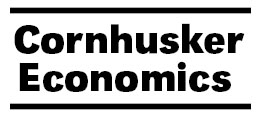Agricultural Economics Department

Cornhusker Economics
Date of this Version
9-26-2018
Document Type
Newsletter Issue
Citation
Cornhusker Economics, September 26, 2018, agecon.unl.edu/cornhuskereconomics
Abstract
Improving farm financial health can come from improving the understanding of the market forces influencing the optimal crop insurance contract and preharvest hedging risk management tools. The biggest challenge for farmers is the difficulty of assessing risk since experiencing risk, is by default, rare. Additionally, farmers receive advice about which crop insurance plan they should purchase or how much pre-harvest hedging they should do from sources, such as farm magazines, that likely do not consider the differences in individual risk exposure. Following the advice of such sources could result in producers being inadvertently exposed to more risk. A producer’s location is a primary factor influencing risk exposure. Figure 1 identifies yield risk exposure by county across Nebraska for irrigated corn production. The blue/dark blue counties have a lower yield risk level than the state average yield risk and the red/orange counties have a higher yield risk than the state average. Crop insurance uses the values in Figure 1 to calculate the premium in each county.
The objective of this article is to identify the influence of risk exposure coming from yields and the yieldprice relation. This information will then be used to discuss the optimal crop insurance and pre-harvest hedging for irrigated corn for two locations in Nebraska.


Comments
Copyright 2018 University of Nebraska